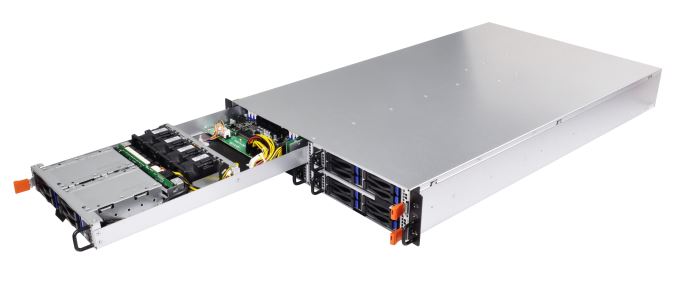ASRock Rack Launches the 2U4N-F/X200: Four 72-core Knights Landing Xeon Phi CPUs in 2U
by Ian Cutress on August 15, 2016 9:00 AM EST
This week is Intel’s Developer Forum in San Francisco, the annual event where Intel and Intel’s partners show their latest products and discuss a number of core topics to Intel’s business. Last year the focus was on the new Skylake microarchitecture, and this year we have down on our list a number of 3D XPoint and Xeon Phi discussions and announcements. One of the first to contact us with their IDF news was ASRock Rack, the server arm of ASRock, about their high-density Xeon Phi solution.

Overview of Xeon Phi X200, Knights Landing
The Xeon Phi many-core platform is transitioning from an add-in card to stand-alone processor, with the latest Knights Landing generation offering up to 72 high performance cores (now a couple of generations away from a pure Atom core) with combined high-bandwidth MCDRAM and the potential for Intel Omnipath support directly on the package. We covered the discussion and launch of Knights Landing last year at Supercomputing15, and saw some preview customer systems at Computex a couple of months ago, however the mix of ISC16 and IDF16 has most of the enterprise consumer-focused system releases surrounding Knights Landing.
For a segment of Xeon Phi customers, density is important. Pack ‘em, rack ‘em and stack ‘em is the end goal, and the 2U4N-F/X200 aims to do just that. The 2U server uses half-width modules to fit in four separate systems in the chassis, each with an X200 Xeon Phi CPU, six DIMM slots with support for DDR4 2400/2133 RDIMM/LRDIMM, four 2.5-inch storage slots (either 4xSATA/SAS or 2xNVMe+2xSATA/SAS), two PCIe 3. X2 slots, one M.2 slot, a combination 1600W 80 PLUS Platinum redundant (1+1) power supply for the four nodes, two GbE Intel i350 network ports and integrated IPMI 2.0 (via AST2400) with KVM and a dedicated LAN port.

P1 Socket for Xeon Phi, seen at Supercomputing15
Xeon Phi uses Intel’s P1 socket, which we saw back at Supercomputing15 and has been characterised in recent media as the LGA-3647 socket. At this point in time, Intel has only confirmed this socket for Xeon Phi use, and other use cases are not yet verified. ASRock Rack states that their platform on show at IDF16 this week will support all the main Xeon Phi X200 CPUs, and they have support in the works for Omni-path associated SKUs. Professional users interested in ASRock’s high-density platform will have to get in contact with their regional branch for more information and pricing.
Source: ASRock



















33 Comments
View All Comments
evilspoons - Monday, August 15, 2016 - link
Yes, argh. I think at this point we should just make VGA illegal.JoeyJoJo123 - Monday, August 15, 2016 - link
I don't think you quite understand why VGA is still in use. It's not because of compatibility with existing infrastructure, it's because it's the only analog video port in relative use today. Everything after it, DVI, HDMI, DisplayPort, etc. have been digital video signals. The only reason a server technician should need to plug in a monitor directly into a server is because they _cannot_ communicate with the server through any other way to troubleshoot it. In this case, they cannot get roadblocked by having an HDMI only server, just to find out that to get HDMI video out, they need drivers, and to install drivers they need to get to the machine, and to get to the machine to install drivers they need to plug in a monitor, and to get video out from a monitor, etc...VGA ports and monitors are literally plug-n-play. There's no HDCP or drivers associated with these ports. The signal fed to the port is analog, the port issues an analog signal to a connected cable, and the monitor reads an analog signal and converts that to a digital image.
Anyone complaining about VGA on server hardware literally has no freaking clue about why it's still around today and why it still _needs_ to be around today.
Mr Perfect - Monday, August 15, 2016 - link
Aggressive post aside, that's a good reason. I've never run into a situation where a server wouldn't give basic video out on a digital connection, so I've learned something here.I was thinking more along the lines of KVMs. It would be nice to have a digital output to use there, instead of extending analog VGA through umpteen wires and switches to end up with a distorted picture back at the console.
jabber - Monday, August 15, 2016 - link
Yes sometimes some things just need no BS hardware that just works...and works. VGA is one of those technologies.azrael- - Tuesday, August 16, 2016 - link
DVI can handle both analog and digital signals in the DVI-I incarnation (which is pretty common). So there's really no need for VGA to still be around, unless the slightly larger connector is an issue (doubt it, though).HollyDOL - Monday, August 15, 2016 - link
DVI can supply both analog and digital signal.Altares13 - Tuesday, August 16, 2016 - link
What do you mean: you need drivers to output a digital signal? Is there a case when a graphics card could output through VGA and not DVI?Mr Perfect - Tuesday, August 16, 2016 - link
That's what he said. I've not seen anything like that in a Windows environment, so maybe it's a Linux or BeOS thing?HollyDOL - Tuesday, August 16, 2016 - link
Doubt it... unless BIOS uses Windows drivers to display POST and stuff :-)nathanddrews - Monday, August 15, 2016 - link
Curious: will we see a consumer Phi AIB?